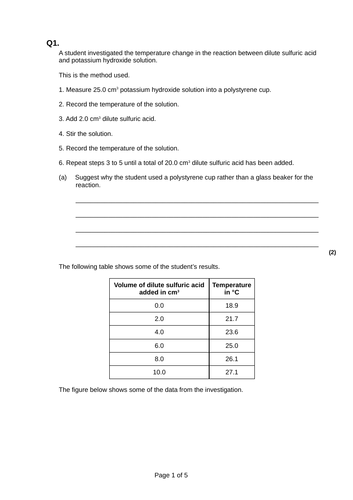
21Uploads
1k+Views
53Downloads
All resources

Year 7 - Boiling and Melting Points (particles) + stearic acid practical
changes of states
heating curves
pure vs impure
stearic acid melting experiment (melt the stearic acid in hot water, recording the temperature at different time intervals. Then plot a graph of the results.)
variables

C5 energy changes + practical + exam questions
Energy is conserved in chemical reactions. The amount of energy in the universe at the end of a chemical reaction is the same as before the reaction takes place. If a reaction transfers energy to the surroundings the product molecules must have less energy than the reactants, by the amount transferred. An exothermic reaction is one that transfers energy to the surroundings so the temperature of the surroundings increases. Exothermic reactions include combustion, many oxidation reactions and neutralisation. Everyday uses of exothermic reactions include self-heating cans and hand warmers. An endothermic reaction is one that takes in energy from the surroundings so the temperature of the surroundings decreases. Endothermic reactions include thermal decompositions and the reaction of citric acid and sodium hydrogencarbonate. Some sports injury packs are based on endothermic reactions. Students should be able to: • distinguish between exothermic and endothermic reactions on the basis of the temperature change of the surroundings • evaluate uses and applications of exothermic and endothermic reactions given appropriate information.

Homeostasis and response Glucose regulation
LO1: State that blood glucose concentration is controlled by the pancreas
LO2 :Describe what happens when blood glucose levels become too high or low.
LO3: Explain how glucagon interacts with insulin to control blood glucose levels
Glucose regulation story board activity
add labels to the sheet for optimum glucose levels
past paper questions
quiz
extension questions
And a differentiated version for lower ability

In Vitro Fertilisation (IVF) GCSE
contraception
infertility
exam style question
fertility drugs
IVF process diagram
Advantages and disadvantages of IVF

A Level Biology - factors affecting biodiversity
LO1: the factors affecting biodiversity
LO2:the ecological, economic and aesthetic reasons for maintaining biodiversity
exam questions
article on biodiversity
keystone species notes

Specific heat capacity, required practical and exam questions
background on SHC
ΔE = m x Δθ x c
practice equations
exam questions

AQA Paper 1 Chemistry past paper questions with answers in powerpoint
starter on concentration of solutions
various questions on paper 1 with answers as animations on ppt

Introduction to electrolysis
Ions revision
Physical Properties of Ionic Compounds
exam questions
OILRIG equations

Year 7 - reproduction - Fertilisation and Implantation
Gametes
video and questions
word fill
key term match up
storyboard activity for stages of fertilisation

Year 7 - principals of organisation (body systems)
animal cells
specialised cells
hierarchy of organisation
Organising a body Questions

Activate P2.3 physics - What is potential difference and how do I measure it?
To be used with Activate 2
To describe what is meant by potential difference
+E = QV questions

Covalent bonding/ simple molecules lesson with molymods
Bonding recap
questions/ answers
molymods practical
intramolecular forces
relative formula questions

OCR vaccination and immunity A Level + exam Qs and maths of efficacy
LO1: To describe the principles of vaccination
LO2: To explain the role of vaccination programs in preventing epidemics.
LO3: To evaluate possible sources of medicines
Keywords: vaccination, immunological memory, herd immunity, secondary metabolites

Eukaryotes prokaryotes and units of measurement lesson
Eukaryotes prokaryotes
Types of cell
exam questions
orderrs of magnification

AQA - water and ions lesson
describe the properties that are important in water
explain the properties of water linked to the polar nature of the molecule
explain the significance of these properties to living organisms and processes.
Explain what is meant by the term inorganic ions and where they occur in the body
Explain the specific role of hydrogen, iron, sodium and phosphate ions
Relate the role of these ions to their properties

GCSE - chromosomes, mitosis and cell cycle
LO:
Describe what a chromosome is and where chromosomes are found in the cell.
Describe simply how and why body cells divide.
Draw simple diagrams to describe mitosis.
Draw a simple diagram to describe the cell cycle
keywords: mitosis, daughter cell, interphase, cytokinesis.
literacy task
draw mitosis stages
true and false
exam questions
mitotic index stretch and challenge

Acids and alkalis: pH and Indicators/ neutralisation
universal indicator practical
evaluating methods of detecting pH
demo acids + alkalis and then use pH indicator
neutralisation practical (you will need 3-4 different types of indigestion tablets)
acid + alkali word equations

Food tests, theory and required practical
LO1: To describe how to test for a range of carbohydrates, lipids and proteins.
LO2: To interpret data and determine if an unknown is a carbohydrate, lipid or protein.
background theory.
food tests mind map
required practical
6 mark question




















